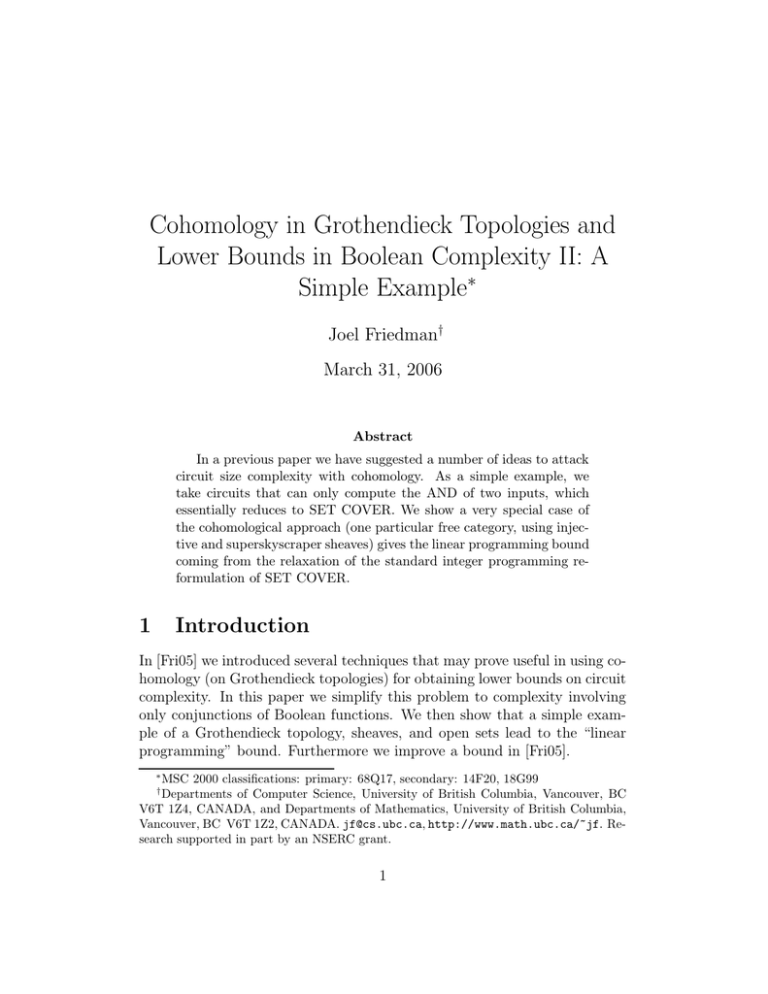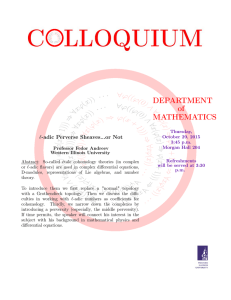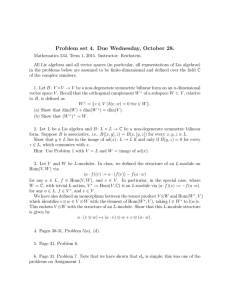Cohomology in Grothendieck Topologies and Simple Example ∗
advertisement

Cohomology in Grothendieck Topologies and
Lower Bounds in Boolean Complexity II: A
Simple Example∗
Joel Friedman†
March 31, 2006
Abstract
In a previous paper we have suggested a number of ideas to attack
circuit size complexity with cohomology. As a simple example, we
take circuits that can only compute the AND of two inputs, which
essentially reduces to SET COVER. We show a very special case of
the cohomological approach (one particular free category, using injective and superskyscraper sheaves) gives the linear programming bound
coming from the relaxation of the standard integer programming reformulation of SET COVER.
1
Introduction
In [Fri05] we introduced several techniques that may prove useful in using cohomology (on Grothendieck topologies) for obtaining lower bounds on circuit
complexity. In this paper we simplify this problem to complexity involving
only conjunctions of Boolean functions. We then show that a simple example of a Grothendieck topology, sheaves, and open sets lead to the “linear
programming” bound. Furthermore we improve a bound in [Fri05].
∗
MSC 2000 classifications: primary: 68Q17, secondary: 14F20, 18G99
Departments of Computer Science, University of British Columbia, Vancouver, BC
V6T 1Z4, CANADA, and Departments of Mathematics, University of British Columbia,
Vancouver, BC V6T 1Z2, CANADA. jf@cs.ubc.ca, http://www.math.ubc.ca/~jf. Research supported in part by an NSERC grant.
†
1
Let S be a set, and denote by BS = {0, 1}S the collection of functions
from S to B = {0, 1} (viewing 1 as TRUE and 0 as FALSE). By a formal
AND measure we mean a function, h, from BS to the non-negative reals such
that for all f, g ∈ BS we have
h(f ∧ g) ≤ h(f ) + h(g)
(compare the notion of a formal complexity measure, e.g., see [Weg87]). Given
a subset S1 = {f1 , . . . , fr }, let size(f ) be the minimum number of elements
of S1 whose conjunction is f ; we define size(f ) to be infinite if f cannot be
expressed as such a conjuction. Equivalently size(f ) is the size of the smallest
formula computing f via conjunctions of elements of S1 . By induction on
“size” we see that for any formal AND measure, h, we have
size(f ) ≥ h(f )/M,
where M = maxi h(fi ).
If h also satisfies
h(f ) = h(¬f ),
then similarly we have an h(f )/M lower bound on the size of a formula as
before, but where the operations are either conjunctions or the negation of a
conjuction; then log2 (h(f )/M ) would bound the formula (or circuit) depth.
Given S and f1 , . . . , fr , determining size(f ) is NP-complete. It can be
approximated (to within O(log r)) by a linear program. We shall show that
the “virtual zero extensions” described in [Fri05], just in the special case of
a free category with sheaves with no non-trivial higher cohomology, give this
linear programming bound (or more precisely its dual). We finish by recalling
the notion of virtual zero extensions.
We sketch the ideas, referring to [Fri05] for the details. Let C be a finite
category, and endow it with the grossière topology (meaning that a sheaf
is the same thing as a presheaf). Let F, G sheaves of finite dimensional Qvector spaces on C, and let U be an open set of C (i.e., a sieve), and Z be
a closed set. We say that a sheaf, H, is a virtual GU,Z if there is an exact
sequence,
0 → GU → GU ∩Z ⊕ H → GZ → 0,
where the maps GU → GU ∩Z and GU ∩Z → GZ are the usual maps (i.e.,
the identity on the intersection of the supports), and where GA denotes G
restricted to A and extended by zero outside A. See [Fri05] for conditions
on the existence of H; for a free category (see [Fri05]) H always exists. The
following theorem is an improvement over the bound in [Fri05].
2
Theorem 1.1 In the situation above, with H a virtual GU,Z , we have
cc(F, GU ∩Z ) ≤ cc(F, G) + cc(F, GU ) + cc(F, GZ ),
where cc(A, B) is the sum of the dimensions of Ext iC (A, B) over all nonnegative i, and Z is the complement of Z.
We shall prove this theorem in Section 3. Now assume that we have a map
f 7→ Uf from BS to open sets of C such that Uf ∧g = Uf ∩ Ug . Then
h(f ) = cc(F, GUf )
is a formal AND measure, provided that cc(F, G) = 0.
The idea to test the ideas of [Fri05] on AND’s alone arose in conversations with Les Valiant. We wish to thank him, as well as Janos Simon, for
discussions.
2
AND complexity
Given S and S1 ⊂ BS , determining size(f ) is NP-complete, as it is almost a
reformulation of SET COVER (see [Vaz01], for example, for SET COVER);
indeed, to determine how many S1 elements we need to obtain f , we may
assume f ≤ fi for all i, and then the question is how many fi−1 (0) are
required to cover f −1 (0). The point of this paper is to show that the dual of
the usual “linear programming” lower bound on size/depth complexity arises
as a very special (and degenerate) case of the sheaf bound. Specifically, the
size complexity is given by the integer program
X
min
µi ,
subject to
X
i∈R
µi (1 − fi (s)) ≥ 1,
∀s ∈ f −1 (0)
i∈R
µi = 0, 1
i ∈ R,
where R is the set of i with f ≤ fi . A lower bound to this program is
given by the “relaxed” linear program where the µi are non-negative reals.
The gap between the integer and linear program is known to be as high as
3
O(log r) in certain cases, and never higher (see [Vaz01]). Equivalent to the
linear program is its dual,
X
max
αs ,
subject to
X
s∈f −1 (0)
αs (1 − fi (s)) ≤ 1,
∀i ∈ R
αs ≥ 0
∀s ∈ S
s∈f −1 (0)
Say that s ∈ f −1 (0) demands fi if fi (s) = 0 and fj (s) = 1 for j 6= i. If
for each i = 1, . . . , r there is an si that demands fi , then we take αs to be 1
or 0 according to whether or not s is one of the si , and then we see that the
LP-bound is exact, i.e., gives the true size complexity (namely r).
For example, consider the case where S = {0, 1}n and the size one functions are {0, 1, x1 , ¬x1 , . . . , ¬xn }; given f , we discard 0, 1 and all size one
functions not ≥ f ; we see that either f is the conjunction of the functions
leftover, and the LP-bound is exact, or f is of infinite size complexity, and
the LP-bound is also infinite (the primal is infeasible, and for the dual there
is an s with f (s) = 0 but fi (s) = 1 for all leftover fi ; then αs can be taken
arbitrarily large).
3
Improved Inequality
In this section we prove Theorem 1.1.
The short exact sequence
β
0 → GU ∩Z → GU →
− GU ∩Z → 0
gives a long exact sequence, yielding
dim(Exti (F, GU ∩Z )) = dim(Coker β i−1 ) + dim(Ker β i ),
(1)
where β i : Exti (F, GU ) → Exti (F, GU ∩Z ) are the maps arising from β. It
suffices to bound the right-hand-side of equation (1).
The virtual zero extension gives a short sequence
β⊕γ
0 → GU −−→ GU ∩Z ⊕ H → GZ → 0.
4
Letting γ i be, as before, the map γ in Exti (F, · ) gives
dim(Exti (F, GZ )) = dim(Coker (β i ⊕ γ i )) + dim(Ker (β i+1 ⊕ γ i+1 )).
Since Coker β i injects into Coker (β i ⊕ γ i ), we have
X
X
dim(Coker β i ) ≤
dim(Coker (β i ⊕ γ i )) ≤ cc(F, GZ ).
And clearly
X
X
X
dim(Ker β i ) ≤
dim(domain(β i )) =
dim(Exti (F, GU )) = cc(F, GU ).
Summing in equation (1) yields
cc(F, GU ∩Z ) ≤ cc(F, GZ ) + cc(F, GU ).
We now finish the proof using
cc(F, GZ ) ≤ cc(F, G) + cc(F, GZ )
that follows from the exact sequence
0 → GZ → G → GZ → 0.
2
4
A Trivial Bound
In this section we use the notation of [Fri05]: if C is a category and P ∈
Ob (C), then kP is the inclusion ∆0 → C where ∆0 is the category with
one object, 0, and one morphism, and kP (0) = P ; also, if u : C → C 0 is a
functor, u∗ is the pullback and u∗ (respectively u! ) is its right (respectively
left) adjoint (this notation comes [sga72], Exposé I, Section 5.1).
Lemma 4.1 Let C be the free category on the graph, G. For a closed inclusion i : Z → C, let HomZ (P, Q) be the set of all paths in G all of whose vertices except the last lie outside Z; in particular, if P ∈ Z, then Hom Z (P, Q)
is empty if Q 6= P and consists of a single element (the zero length path about
P ) if Q = P . For any P ∈ Ob (C) we have that
M
i∗ i∗ k P ∗ Q '
(kQ∗ Q)HomZ (P,Q) .
(2)
Q∈Z
5
Proof Let FL , FR denote the sheaves on the left- and right-hand-side of
equation (2). First note that i∗ i∗ is simply restriction to Z followed by
extension by 0, and FR clearly vanishes outside Z. So it suffices to give
anisomorphism FL (X) ' FR (X) for each X ∈ Z that is functorial in X.
We have that (kP ∗ Q)(X) is Hom(P, X) copies of Q, and Hom(P, X) is
the number of paths in G from P to X. For each path in G from P to X,
once a vertex in the path, Q, falls in Z, all subsequent vertices remain in Z.
Hence we have a set theoretic bijection
[
bX :
HomZ (P, Q) × Hom(Q, X) → Hom(P, X)
Q
for each X. Furthermore this bijection is functorial in X, in that if φ : X1 →
X2 is a morphism, then we have that φbX1 = bX2 φ, the second φ acting on
each Hom(Q, X1 ). This gives the desired functorial isomorphism FL (X) '
FR (X).
2
Now let S be a finite set, and let MS be the graph whose vertices are
the functions S → {0, 1} with one or zero edges from f to g according to
whether or not f ≤ g and f (s) = g(s) for all but exactly one s ∈ S. Let
C be the free graph on MS . We call MS the monotone S-cube, and C the
S-path category. For f ∈ Ob (C), let Uf be the smallest open set containing
f , i.e., the set of all objects no greater than f . By a subcube of C be mean a
collection of objects whose values at a subset of S are fixed.
Consider the model, f 7→ (C, F, GUf ), where G = kP ∗ Q and where F and
P are to be specified later. Since C is free, virtual zero extensions always
exist. If Zf denotes the complement of Uf , we have
X
(dim F (Q)) |HomZf (P, Q)|.
cc(f ) =
Q∈Zf
Of course, the dim F (Q) can be arbitrary non-negative integers by taking
F to be a sum of superskyscraper sheaves, i.e., a sheaf, F , where for each
morphism φ ∈ C we have F φ is the zero morphism.
We claim this recovers the linear programming bound. Indeed, let P = 0,
and let F vanish outside of the points δs where s ∈ S and δs is the Dirac
delta function at s. Then cc(F, G) = 0, since F (0) = 0, and
X
cc(g) =
As (1 − g(s)),
s
6
where As is the dimension of F (δs ). So we get
X
size(f ) ≥
As /M,
s
for any M with
X
As (1 − fi (s)) ≤ M ;
s
this is just the linear programming bound (restricted to αs = As /M rational, αs as in Section 2). Furthermore, it is not hard to see that varying
G injective and F arbitrary and taking linear combinations we cannot get
anything better than the linear programming bound. Indeed, since f = 0,
we have cc(f ) = 0 unless P = 0; so any P 6= 0 terms can be discarded in an
optimal bound. Similarly, if P = Q, then cc(F, G) is already 1 and cc(f ) is
no greater, so such terms can be discarded (since the bound size(f ) ≥ 1 can
always be achieved by the linear program). Finally, if P = 0 and Q 6= 0 and
Q 6= δS , then
X
cc(f ) =
NP,Q (A, B)ccA,B (f ),
(A,B)∈ES
where ES are the edges of GS , NP,Q (A, B) is the number of paths from P to Q
in GS that pass through the edge (A, B), and ccA,B denotes the cohomological
complexity when P = A and F is zero outside B and Q on B. In the above
displayed sum we may discard the A with A 6= 0, as mentioned before, and
we are left with a cohomological complexity as before.
The bound we get on size(f ) can, of course, be derived without cohomology. Indeed, consider any formal function
X
h(f ) =
A(φ),
(3)
φ∈HomZf (P, · )
where A is a any non-negative function. Then h is a formal AND measure,
since HomZf ∧g ⊂ HomZf ∪ HomZg .
We pause for a mild generalization of this notion. By a conjuctively
closed family we mean an C ⊂ BS such that f, g ∈ C implies f ∧ g ∈ C;
by a conjunctively closed complement we mean the complement in BS of a
conjunctively closed family, or equivalently a B ⊂ BS such that f ∧ g ∈
B implies at least one of f, g lies in B. For such a B, we have χB , the
characteristic function of B is a formal AND measure, and therefore so is
7
any non-negative linear combination of such characteristic functions; this is
an essential generalization of the h in equation (3).
Let us mention that taking G = (kP ∗ Q)U for an open set, U , yields such
a bound; indeed, it is not hard to see that we get cc(f ) as in equation (3)
with A(φ) = β(tφ) with
β(Q) = dim F (Q) + dim V (Q) − 2 rank(M ),
where
V (Q) =
M
F (tχ),
χ∈HomU (Q, · )
and M : V (Q) → F (Q) is the map whose χ component is F (χ); clearly β
(and therefore A) is non-negative.
References
[Fri05]
Joel
Friedman.
Cohomology
of
grothendieck
topologies
and
lower
bounds
in
boolean
complexity.
2005.
http://www.math.ubc.ca/~jf,
also
http://arxiv.org/abs/cs/0512008, to appear.
[sga72] Théorie des topos et cohomologie étale des schémas. Tome 1:
Théorie des topos. Springer-Verlag, Berlin, 1972. Séminaire de
Géométrie Algébrique du Bois-Marie 1963–1964 (SGA 4), Dirigé
par M. Artin, A. Grothendieck, et J. L. Verdier. Avec la collaboration de N. Bourbaki, P. Deligne et B. Saint-Donat, Lecture Notes
in Mathematics, Vol. 269.
[Vaz01] Vijay V. Vazirani.
Berlin, 2001.
Approximation algorithms.
Springer-Verlag,
[Weg87] Ingo Wegener. The complexity of Boolean functions. Wiley-Teubner
Series in Computer Science. John Wiley & Sons Ltd., Chichester,
1987.
8





